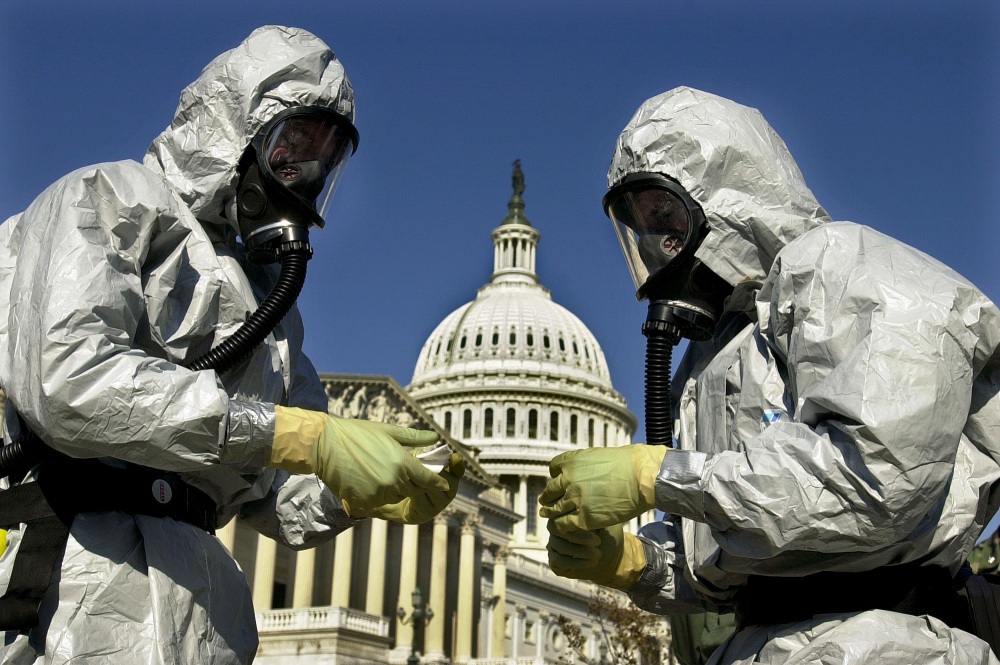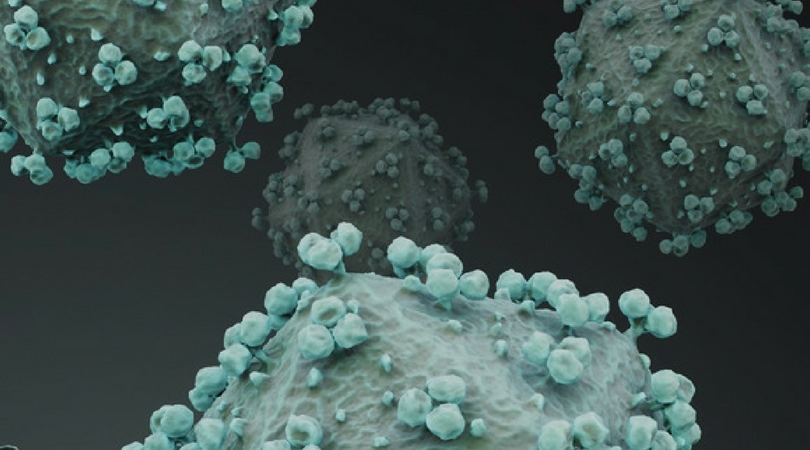
Dr. Mark S. Smolinski, testified at the 2005 Meeting of Experts of the Biological Weapons Convention in Geneva
NTI Global Health and Security Initiative
before the BWC Experts Meeting
Mark S. Smolinski, M.D., M.P.H Testimony
Slide 1: Title
Good morning. Mr. Chairman, thank you for the opportunity today to provide some insight on the work our foundation has been supporting that we feel can inform your deliberations on the role of codes of conduct in reducing the potential misuse of life sciences’ research and technology.
Slide 2: NTI
The Nuclear Threat Initiative (NTI) is a nonprofit organization that has been uniquely successful in leveraging its resources to fulfill our mission of strengthening global security by reducing the risk of use and preventing the spread of nuclear, biological and chemical weapons.
NTI seeks to raise public awareness, serve as a catalyst for new thinking and take direct action to reduce these threats.
NTI is led by former U.S. Senator Sam Nunn and governed by an international Board of Directors with members from the United States, the United Kingdom, France, Russia, India, Pakistan, China, Japan, Jordan and Sweden. Warren Buffett, CEO of Berkshire Hathaway Inc., and Joshua Lederberg, Nobel Laureate, serve as advisors to the Board of Directors. NTI is principally funded by business leaders Ted Turner, Warren Buffett, Bill Gates, George Russell, and J.B. Fuqua.
Slide 3: Global Health and Security Initiative
NTI’s Global Health and Security Initiative has shaped and supported a number of innovative projects that offer new insight and understanding that can help shape current and future policy and action. Pertaining to the focus of this Experts Meeting, NTI continues to work towards engaging the international biomedical research community to develop ideas for constraining the harmful use of biological research and development without unduly encumbering the pursuit of science for scholarly or beneficent ends.
Slide 4: Truths of Science
Most people would agree that there are certain truths (little “t”) of science. The first is that research in the life sciences is good for society. Without life scientists we would not have important drugs and therapeutics that offer better preventive measures and treatments for a myriad of human and animal diseases. Society generally views this as a good thing, and as a reason to continue public support of life science research.
The second “truth” is that science is advancing exponentially. In 1965 Gordon Moore, co-founder of Intel, made the prediction that the number of transistors per square inch would double every year following the discovery of the integrated circuit. Similar to Moore's law, the cost of sequencing DNA into strings of nucleotides falls dramatically every year, to the point where a single U.S. company (Celera) was able to challenge a multinational consortium of government labs in a race to sequence the human genome.
The third “truth” of science is that experimentation not only can be, but often is, unpredictable. More often than not, the result is ambiguous, or gives a different answer than the one expected. This is how science progresses. It is in the unpredictability that we often arrive at the most interesting outcomes in science.
Finally, and arguably most importantly, scientific progress relies on openness and the transparent sharing of information. The free exchange of information is considered fundamental to the advancement and culture of science.
Slide 5: Dilemmas of Science
Unfortunately, some of the same truths of science result in serious dilemmas for national and international security.
As discussed, experimentation in science can lead to unforeseen results. Often times, an unexpected result from experimentation will open whole new avenues of research or even lead to advances in medicine, such as the unplanned discovery of penicillin by Alexander Flemming.
Ironically, a good deal of life science research depends on using the same deadly pathogens that are potential biological weapons to develop, test and produce vaccines and therapeutics and advance human health. Several groups have identified areas of science that are at a heightened risk for misuse, including such research on dangerous pathogens.
The spectacular pace of progress in 21st century technology – biotechnology, nanotechnology, information technology, and many other areas – has increased such that the rate of discovery is outstripping conventional security planning. The challenge is to balance security and scientific progress without making us less secure, or impeding legitimate research.
However, the essential openness of the life science enterprise means that life science knowledge and technologies can be misused for malevolent purposes.
Slide 6: Multi-pronged approach
NTI has been working for the past few years to help address the dual-use dilemma. We have supported a number of projects designed to engage multiple sectors with a stake in this issue, thus providing different perspectives—both within the U.S. and internationally.
Specifically we have funded a blue ribbon scientific panel study by the U.S. National Research Council; engagement of the academic community through a study on self-governance by scientists through the Johns Hopkins Center for Civilian Biodefense Strategies, now under the auspices of the University of Pittsburgh Medical Center, Center for Biosecurity; and finally, to engage business and industry through the creation of a bioindustry standards organization by the Chemical and Biological Arms Control Institute and the International Institute for Strategic Studies-United States. You will be hearing more detailed descriptions of these projects as the institutions we supported make presentations later this morning. However, I wanted to highlight some of the key lessons gleamed from our efforts.
Slide 7: National Research Council
Together with the Alfred P. Sloan Foundation, NTI funded what has now become a landmark report from the U.S. National Academies. This report, entitled Biotechnology Research in the Age of Terrorism, provided a framework for addressing the potential misuse of the life sciences research.
Slide 8: NCR Recommendations
Some of the specific key recommendations include:
- Create programs to educate scientists about the nature of the dual use dilemma in biotechnology and their responsibilities to mitigate its risks
- Rely on self-governance by scientists and scientific journals to review publications for their potential national security risks
- Create an International Forum on Biosecurity to develop and promote harmonized national, regional, and international measures that will provide a counterpart to the system recommended for the United States (which is the National Science Advisory Board for Biosecurity, discussed in depth before the BWC Experts during yesterday’s presentations)
Slide 9: Life sciences Self-Governance
To further explore the issue of self-governance by life scientists, NTI funded a project with the University of Pittsburgh Medical Center, Center for Biosecurity, with the following conclusions.
- Because of their first-hand knowledge and experience, scientists need to publicly articulate what the risks are, what preventatives measures can be taken, and what policies should be put in place.
- Responsibility for safeguarding biological knowledge from malignant application should start with scientists at the laboratory bench, and any approach for managing the risks of dual-use biology should directly engage them.
- Managing the dual-use dilemma will also require life scientists to build relationships with the security communities, and find a common goal in preventing life-saving research from being misapplied for weapons.
- The development of ethic codes, or codes of conduct as part of selfgovernance could create an enabling environment for voluntary reporting by people who notice unusual behavior by fellow researchers.
Slide 10: Establishment of Bioindustry Standards Organization
Understanding that the life science research community is multidisciplinary, NTI supported a project to engage participants from government, industry, academia, and other organizations to discuss ways to safeguard the legitimate use of life sciences. As an outcome of this engagement, biotechnology industry and academic leaders came together to create the International Council for the Life Sciences.
The mission of the Council is to promote public health, safety, and security by safeguarding the opportunities offered by advances in the life sciences and their application.
Slide 11: International Council for the Life Sciences
The ICLS is chartered to be a self-sustaining global organization for the life sciences community to contribute to improved quality of life and enhanced public safety and security. The ICLS will help to
- Promote engagement of the life sciences community worldwide on issues of public safety and security
- Facilitate effective partnerships between the various elements of the life sciences community, including private industry, academia, and government; and
- Serve as an authoritative source of objective consideration and analysis of global biological risks in relation to advances in the life sciences and their application.
Slide 12: International Forum on Biosecurity
Finally, as an opportunity to unite many of our previously funded projects and to create promising linkages and engagements for work in the future, NTI recently supported an International Forum on Biosecurity cosponsored by the InterAcademy Panel on International Issues (IAP), The InterAcademy Medical Panel (IAMP), the International Council for Science (ICSU) and the U.S. National Academies (NAS). The meeting served to bring together the leaders of the international scientific community with other stakeholders to discuss key issues, share information, and brainstorm about potential further actions to be taken independently and collectively to prevent the misuse of life sciences research and technology. This meeting provided a focal point for several organizations to discuss plans for providing input to this very BWC Experts meeting on codes of conduct.
Slide 13: Conclusions
So, where has all of this investment brought us?
To date, our investments have reinforced our initial assessment that it is imperative to tackle the challenge of safeguarding the life sciences through a multidisciplinary approach. We must continue to engage various sectors of the biomedical science and security communities, and we must better integrate our activities, our plans, and our strategies as we move forward.
We realize it is not only impractical, but nearly impossible to regulate all life science research in pursuit of security. The knowledge, tools, and information needed to create a biological weapon are already available in the open literature. Scientific and medical advances depend on new experimental results, publications, tools and knowledge being shared amongst life scientists. The danger would be in constraining legitimate research in favor of overbearing security. The problem is that by constraining research, we might lose out on scientific advances important for human health.
Having said that, there are areas of research that have a clearer potential for misuse. For example, the world community is rightly concerned about potential new experiments with Variola major (the virus that causes smallpox). Smallpox has been eradicated in nature, and we must exercise caution when performing research with the virus.
But, paradoxically, a focus on constraining access to certain agents and knowledge surrounding their weaponization tends to divert attention from the fact that all areas of science can produce unexpected results that might lower the barrier for creating a biological weapon. Clearly, this is a difficult and multifaceted problem that requires creative new approaches to controls, and must actively involve the bioscience research community.
The irony of creating new barriers to research might be to discourage the best bioscientists from conducting the very research the world community needs. If anything, government actions may serve to disengage a new generation of bioscientists. Likewise, it is feared that significant research funding will be diverted to pay for the required laboratory surveillance and facility registration requirements—without ensuring a commensurate increase in security.
Slide 14: Recommendations
How can we balance the benefits of free and open exchange of scientific information against the likely need to protect a narrowly defined set of information that could be dangerous in the wrong hands? For starters we need to ensure that life scientists are aware of security concerns and requirements as they conduct their research. We need to increase the education, awareness and understanding of security concerns among the life scientists. As noted earlier, scientists are in the best position to understand the true implications of their particular research and to take appropriate actions to mitigate the misuse of their results.
An institutional culture of responsibility must be created and nurtured in the life science community that empowers researchers to integrate security considerations in the planning and conduct of their research. One way to accomplish this is through a code of conduct.
While adopting codes of conduct is a necessary step to raising awareness of dangers and responsibilities, alone they are not a sufficient solution to the problem of misuse of science.
Additionally, no one code will fit all user groups. Codes of conduct will be more readily accepted if they build upon existing institutional guidelines and principles and are developed in collaboration with the scientists to whom they will be directed. A code-of-conduct should be the end point in a process of education and awareness-raising.
It might be best to think of codes of conduct as just one of the many tools that need to be better developed and implemented in safeguarding against the misuse of science. The International Committee of the Red Cross refers to this approach as building a “web of prevention.” Each thread of the web may be weak on its own but together can serve the purpose. A broad-based approach built on an ever-evolving set of measures, or tools, may be the best way to respond to the dual-use risks posed by the global proliferation of advancing technology.
Further, we need innovative strategies for oversight and responsible stewardship of science. The newly formed NSABB in the United States will hopefully provide some of those new strategies that can be supported by the international community.
Finally, given the international dimension of bioscience research, any serious attempt to prevent the misuse of science for malevolent purposes must include efforts to harmonize standards and practices internationally. It is important that the experts groups move the BWC process forward into the 2006 review conference. One first step might be developing and harmonizing national biosecurity laws for controlling access to dangerous pathogens.
Slide 15: Final Thought
Arriving at solutions for preventing the misuse of the life sciences…is longterm and life-long.
Our diversity of NTI-supported projects has allowed us to test, on a small scale, an integrated approach to safeguarding the life sciences. We believe that one of the benefits to this approach has been the creation of greater awareness and better communication among various sectors in the science and security communities. This approach should be replicated on an international basis to achieve the kind of progress we must have to protect ourselves against the malevolent use of life sciences in the future.
Slide 16: Thank You
Stay Informed
Sign up for our newsletter to get the latest on nuclear and biological threats.

Tutorial on Biological Weapons Nonproliferation
Understanding biological weapons, as well as biosafety, biosecurity, and BW nonproliferation, is the focus of this tutorial.

Biological Weapons Non-Proliferation
Understand biological weapons, as well as biosafety, biosecurity, and BW nonproliferation.
Laura S. H. Holgate testifies before the House International Relations Committee — Subcommittees on Europe, International Terrorism, Nonproliferation and Human Rights
In this testimony, Ms. Holgate discusses U.S. progress toward reducing the threats from nuclear, biological and chemical weapons, where we are heading, and whether we are getting there fast enough.
